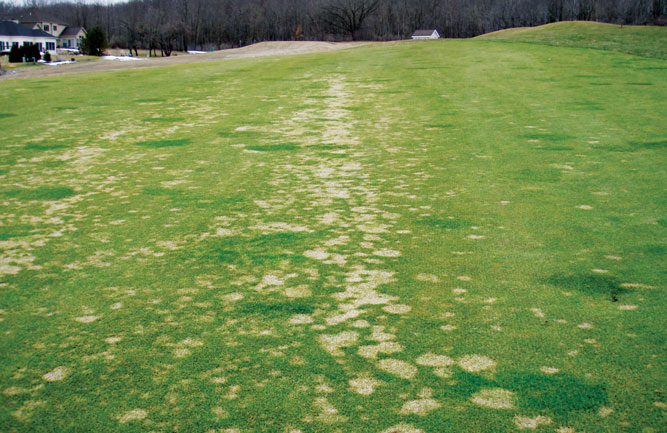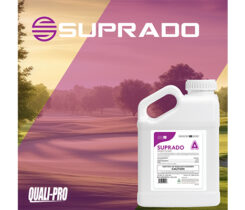Experts share how to prevent gray snow mold damage

Adam Thoms, Ph.D. (Photo: Adam Thoms)
To decrease the odds of gray snow mold damage, Adam Thoms, Ph.D., associate professor in the department of horticulture at Iowa State University, advises superintendents to mow their rough at 2.5 inches. In doing so, they’ll reduce matted turfgrass considerably.
Additionally, superintendents should add snow fences to their courses and remove snow from greens after 60 to 90 days of steady snow cover. After all, the disease thrives amid long periods of snow cover.
“To further limit conditions that are favorable for disease development, superintendents can also trim trees, which, in turn, increases sunlight so that the snow cover melts,” Thoms says.
To prevent or not to prevent?
Of course, gray snow mold damage varies from one area to the next, a factor that superintendents must also consider. Thoms says it’s ultimately up to them whether they want to only spray their greens for cost savings or spray their greens and tees, particularly if their course will likely have prolonged snow cover.
“The bottom line is this: do the costs of preventative treatments outweigh the costs of potential damage?” Thoms asks. “Each superintendent must reach their own conclusions, based on previous weather patterns and gray snow mold damage.”

Gray snow mold typically appears in places that experience long periods of snow-covered ground. (Photo: Paul Koch)
Cultural controls
Last year, various regions in the U.S. had a gray snow mold outbreak. Although Iowa’s outbreak was not nearly as damaging as other states, Thoms noticed many local superintendents raked their courses’ turfgrass so that it either stood back up or avoided matting.
He says Iowa superintendents also applied fertilizers to help stimulate turfgrass growth and recovery, mowed to remove damaged tissue and freshen up the appearance of the turf and removed trees to speed up snowmelt — a priority that more and more superintendents consider.
“I also think they were comfortable with fungicide programs, as sprayed areas were protected and didn’t see damage,” Thoms says. “Therefore, once bentgrass is going dormant, superintendents should get their fungicide sprays out. Timing is always key for successful protection.”

Matt Giese, M.S. (Photo: Syngenta)
Syngenta
Matt Giese, M.S., technical services manager
Gray snow mold on turfgrass can be a challenge to manage, especially when the infection process occurs in cold temperatures and under snow cover. Visible symptoms are generally not observed until spring melting begins. In addition, fungicide treatments are not effective at suppressing this disease in the spring after the snow has melted. As a result, unsightly damaged areas can persist well into the summer months before full recovery occurs. The best strategy to reduce or prevent damage is to plan for fungicide applications in the fall after mowing has ceased, but before permanent snowfall occurs. Since gray snow mold requires extended snow cover for growth and development, regions that lack continuous snow cover tend to have considerably less gray snow mold.
By observing snow cover duration along with turfgrass damage in the spring, superintendents will be able to determine if they need preventive control measures.

Bret Corbett (Photo: Prime Source)
Prime Source
Bret Corbett, technical services manager
Gray snow mold can occur really anywhere in which wet conditions persist during the winter months. There are many cultural practices superintendents can conduct to reduce infection. For instance, by aerifying and verticutting, along with any other practices that remove as much thatch as possible, they’ll be able to combat snow mold. They must ensure they continue to mow until growing ceases, too. The biggest key to control is preventative sprays in the fall. Typically, superintendents need a combination of fungicides for effectiveness. As an example, they can combine a contact fungicide with QoIs, DMIs and SDHIs. Managing healthy turfgrass is the best way to prevent gray snow mold or decrease its severity. By following best management practices, developing an IPM program and getting ahead with proper scouting — while also ensuring they use preventive fungicides before the snow cover occurs — superintendents will have a better chance of eliminating disease pressure.

Aaron Hathaway (Photo: Nufarm)
Nufarm
Aaron Hathaway, technical services manager
For gray snow mold prevention, there are a few cultural practices that can limit pathogen growth and subsequent disease symptoms, especially in areas that have snow cover for long periods. First, avoid quick-release nitrogen applications late in the season as new growth is more susceptible to gray snow mold. Furthermore, apply one or two fungicide applications before snow falls for the winter. Remember to apply fungicides in 1 to 1.5 gallons of water per 1,000 square feet to ensure thorough coverage. Apply a fungicide (or fungicides) with more than one active ingredient, each of which has activity on gray snow mold. Tebuconazole and PCNB both have relatively superior activity on gray snow mold. Although these active ingredients (AIs) provide superior control, combinations of AIs offer more consistent and effective control of gray snow mold. Apply the treatment (or the second of the two) as close to the snow event that’s likely to produce snow that remains for the season.

Ian Rodriguez, Ph.D. (Quali-Pro)
Quali-Pro
Ian Rodriguez, Ph.D., technical services manager
Most preventive gray snow mold fungicide programs consist of one or two applications prior to the first snow cover of the season and as close to the snow event as possible. Since gray snow mold develops after about 60 days of continuous snow coverage, there aren’t any opportunities to make an effective application once the snow is on the ground. Applying too early can result in a significant loss of fungicide efficacy if the snow is delayed long enough. Research shows that the best approaches consist of multiple modes of action, often combining contact with systemic active ingredients. In regard to prevention changes concerning locations, the biggest difference is likely judging whether or not to spray in milder areas, which may not typically see extended snow cover. That said, once the snow is there, it’s too late to apply anything. If there’s any recent history of snow mold on a property, it’s worth considering preventive measures.












